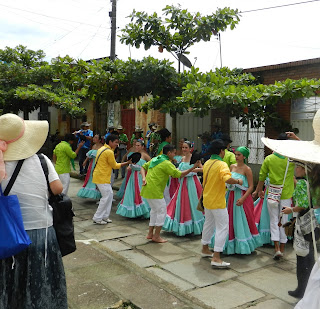 | ||
| Some members of our group in costume. |
Following the 'Route of the Comuneros" our group made it's first stop in Puente Nacional, named for being the “National Bridge” where the first fight
between the commoners (Comuneros) and the Spanish crown took place on May 8, 1781. In the state of Santander
there were no shots fired and no blood was spilt (unless someone fell down from
being drunk that day). So 231 years later, the people of Colombia dressed up in
period costumes for both sides – the communeros and the aristocracy – and celebrated
the success of that day and all the days that followed to bring them to where
the city is today. This feat brought the people of Colombia their independence
on August 7, 1819.
 |
| Comunera & Aristocrat |
Puente Nacional is also recognized as a great ecotourist
stop at approximately 5300 feet in the foothills of the Cordillera Oriental of the Andes with over 680 beds and the ability to feed 2,000 people daily. While the
hotel (Hotel Colombia El Dorado) we stayed at was clean and moderately comfortable, I cannot possibly imagine their
restaurant being able to keep up with more than 20 people since our food was
less than stellar in both timing and quality, a minor hiccup in our trip. Agriculture and growing of livestock seem to be the primary economic activities of the region, but to be honest I didn't have time to talk to anyone about this aspect of the area.
 |
| Dancers are rehearsing as we arrive in Puente Nacional. |
Promoted across the country as the biggest ‘Feria’ in
Colombia, a celebration of the First Comunera Victoria, (Primera Victoria Comunera) there were indeed visitors from Bogota,
three hours to the south, and also from Bucaramanga, four hours to the north
and plenty of other places as well judging from the license plates on the
parked cars. Surely most of the 5,600 local townspeople and a good portion of
the over 12,000 rural residents were also crammed into the town square to enjoy
the activities. Almost everyone was wearing the Comunero costume of black skirt or pants, white blouse and a sombrero and some added the red necktie.
 |
| Meat hanging and other samples awaiting your pleasure. |
We arrived on Saturday, May 5, about 9:30 a.m. after getting
up at ‘screech o’clock’ to be on the bus by 6 a.m. If we had not stopped for a
much-needed breakfast, we could have arrived even earlier in time to hear the
Marching Band going through the streets at 4 a.m., attending the Rosary Mass at
5 a.m. and then joined in watching the students of numerous educational
institutions parade past to the Lelio Olarte park where the formal ceremony
began at 9 a.m. with the singing of the various hymns of Colombia – the
national song, the state song and the city song. The park was named for the
composer, Lelio Olarte Brown, born December 4, 1882 responsible for creating “Guabina,
Guabina” well known throughout Santander, if not the rest of the world.
 |
| Technical college theatrical group in park plaza; city offices in background. |
 |
| The Comuneros call for freedom from the foppish fellow in the blue coat to the left (photo) threatening more violent actions which never transpired - then or now. |
 However, we did arrive in time to see the impressive
theatrical presentation of the Comuneros and the Indigenous tribes facing off due to the
conflicts caused by the Spaniard arrival along with the various religious
leaders, the aristocracy and the troops wanting to control the lands and the
people. The fervor of the Comuneros came across easily in today’s youth as the
actors of the past.
However, we did arrive in time to see the impressive
theatrical presentation of the Comuneros and the Indigenous tribes facing off due to the
conflicts caused by the Spaniard arrival along with the various religious
leaders, the aristocracy and the troops wanting to control the lands and the
people. The fervor of the Comuneros came across easily in today’s youth as the
actors of the past.
Along with this energetic presentation, there were examples
of old equipment for sugar cane production, leather making, forging metal,
making coffee and brandy, pulling sisal for weaving and samples of various
foods along with pottery and numerous other crafts for sale.
 |
| The Indigenous tribes wanted their lands back, but they had to settle for not being under Spanish rule. |
We left after lunch for a trip to Velez, which will be the
subject of the next entry.
After our return from Velez that night, we all
decided to get a snack before the Tiple (guitars with 12 strings playing a particular type of music) concert. While it was a nice
concert and some lovely music, the day’s activities had worn me out and I was
not alone in my desire to find a place to stretch out. Most of the group
retired for the night and I didn’t have much time to read before my eyes were
closing, even though the bed was only slightly softer than the floor.
NEXT: Velez – the first place in the world to give
women the right to vote!



